GETTING THERE

UKRAiNATV makes sense through lived experience. And is capable of transforming you. It’s a polymorphous and a liminal space. Probably, if you watched the stream, you’ve either been there, or you’ll soon pay us a visit. This is how I got there and how it turned one hard-headed, rational academic into a zany and spiritually awakened jester.
I first visited the studio on February 24, 2023, the first anniversary of the Russian full-scale invasion of Ukraine. A 24-hour livestream event, an art marathon and cyber-ritual all at once. I was just in time to watch a performance piece that resounded of Cassandra’s ancient futile cries against the war on the walls of Troya. I saw a gathering of witches conjuring spirits and doing tarot readings; tuned into to the heavy pounding of industrial techno; observed the frantic crew members running from one computer or camera to another; and listened to the moving declarations by people whose lives were uprooted by the war. Seeing colorful freaks saluting the heroes fighting for their motherland on the frontlines sent chills down my spine. Here, experiencing art as truly cathartic exerted on me a pull so strong that a mere month later I was spending every day with the crew.
It wasn’t just another art experiment. It was an intense communal emotional journey testing everyone’s limits culminating only with the crew’s collective breathlessness. Forced entertainment. They Shoot Horses, Don’t They?
The mix of playfulness and solemnity, digital and physical, created a unique space that felt both welcoming and oddly disturbing. The commitment of the team members who, many a time, crawled under tables to take a short nap, and when refreshed, took to the stage or stood behind the consoles with freshly found vigour, convinced me that something unusual was brewing in this secluded place, an old car workshop, in a courtyard within a courtyard, behind a fence you needed to know how to cross (become initiated). I was hooked.
The ritualistic and cathartic aspects of the performances nurtured a unique space to come into being where emotions could be explored and released. Moved by the movements of this collective, chaotic, yet always purposeful, often exasperated crew, left on me on my first visit, I became a part of the UKRAiNATV’s team.
This happened during a strange moment in my life. Not all that less strange than the amazing adventures of Tyler Durden. After a long fight for my life and a perplexing journey towards redefining myself in the wake of a near-death experience, I was looking for ways to rekindle my connections with life. Not only was I battered by fate but also I struggled to find purpose after having become jaded with the stiff, traditional social ways of doing things – with more precision and a little less heart – at the university. Publish or perish, we all know the drill. The art academy extension off Berka Joselewicza Street offered a recluse from that.
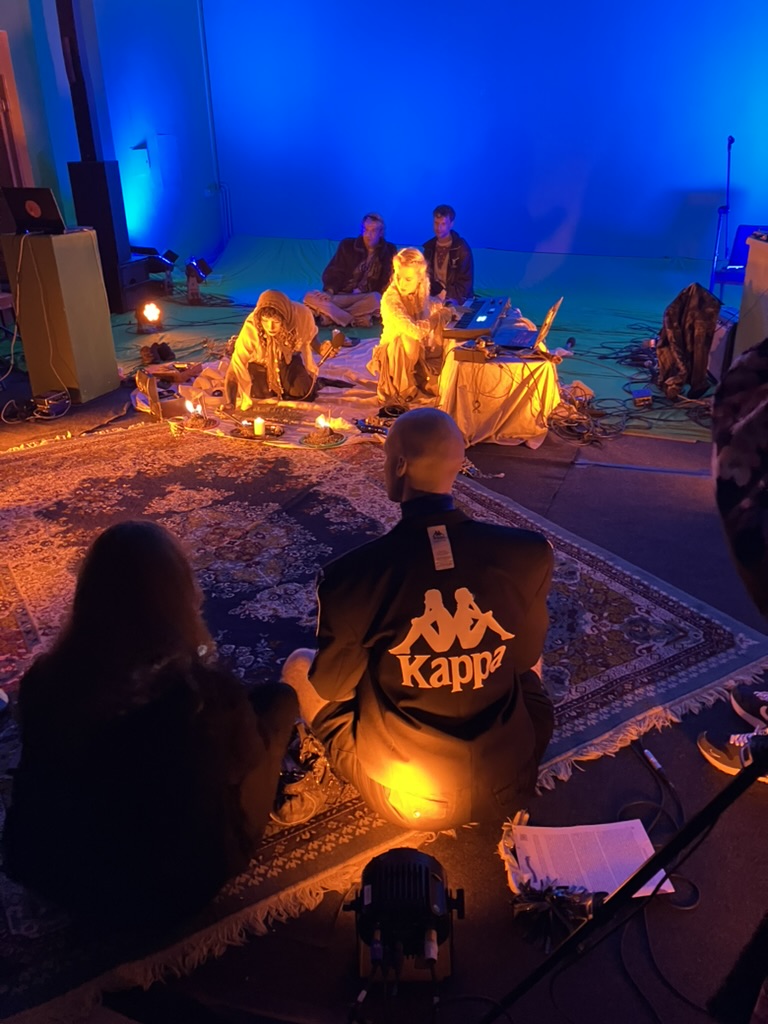
Of course with the team members moving at supersonic speeds to produce one show after another (in a truly Rainer Fassbinder-type fashion), there was still performance pressure! As there was always too much to do, things could not be practised beforehand. Things were arranged on the fly, the broadcast program was scheduled 5 minutes before its start as members were running around the studio to set up the cameras and solve at least one technical breakdown that just so happened to manifest. Once I found myself pushed on stage with a task to think of something for the audience, another time, out of the blue, I was re-staging an old performance of John Cage using kitchenware. We were constantly surprised by the zany inventions of other members.
The high-octane, haphazard workflow was in striking contrast to what I knew: the ways of doing things at academia, slowed down by old institutional rituals and even further by new waves of bureaucratic innovation. If university work was all about decelerating in conditions of high pressure, UKRAiNATV demanded acceleration at lower pressures. Even if you make a mistake, who cares and who is to define what qualifies as a mistake? Error, unpredictability, noise saved the day at the studio, even if, sometimes, the job proved to be to demanding: complex, and exhausting.
I found myself tired of academic writing. It felt like putting ready-made parts together on a mechanical assembly. I felt like constructing texts bound by rigid rules—from grammar to methodological orthodoxy—reminiscent of the esoteric debates of medieval scholastics. Instead of at least assembling parts of roaring, metal beasts – a job one could still fetishize (Crash, Formula 1) or romanticize (the figure of a muscular mechanic covered in sweat and car grease), I found myself assembling words according to layers of rules and limits – from orthography to methodology – to produce codices as obscure and inaccessible as scholastic musings on ‘angels dancing on pinheads?’ or speculations on ‘Virgin Mary’s supposed ability to conceive children through the ear?’
In contrast, working at UKRAiNATV involved a form of alienation, namely, a technological one, of losing oneself in the complex thicket of cables and the cross-fire of camera lenses. However, the means of production remained in the hands of the workers who did with them whatever they wanted. The only rule that I gave in to with pain was cleaning the dishes after the show was over.
Instructed by German media theorist Friedrich Kittler, I knew that universities descend from monastic schools, yet I couldn’t help but notice that this regressive trend only accelerated in recent years, especially during the pandemic. Not even a hint of Athenian academia? No lectures bare-chested under the scorching sun? No heated discussions ending with a brawl? At the very least, allow me to write a 100-page essay on the ‘true nature of things’. I found myself retreating into an ivory tower, alienated from a public that no longer gave a fuck about scholarly nobility, now enclosed in towers within towers.
Zoom cells. Zooming out.
In stark contrast, joining this collective where my skills as a media theorist, a researcher of modern culture, and a philosopher by vocation could be used for some other purpose than writing or lecturing was a revitalizing experience. It was like swapping noble but damp chambers for a poor but airy barrel for a moment (it was still much better for my back!). Here, theory could transcend its academic constraints and merge with art. I was finally working at an intersection (like an intellectual in all those Londons and Berlins of the world). It was the dialogue, not text, that became my primary medium. I was free to preach media theory to random souls who weren’t expecting a lecture in media theory during a cigarette break. The effect of surprise only made those meetings more valuable.
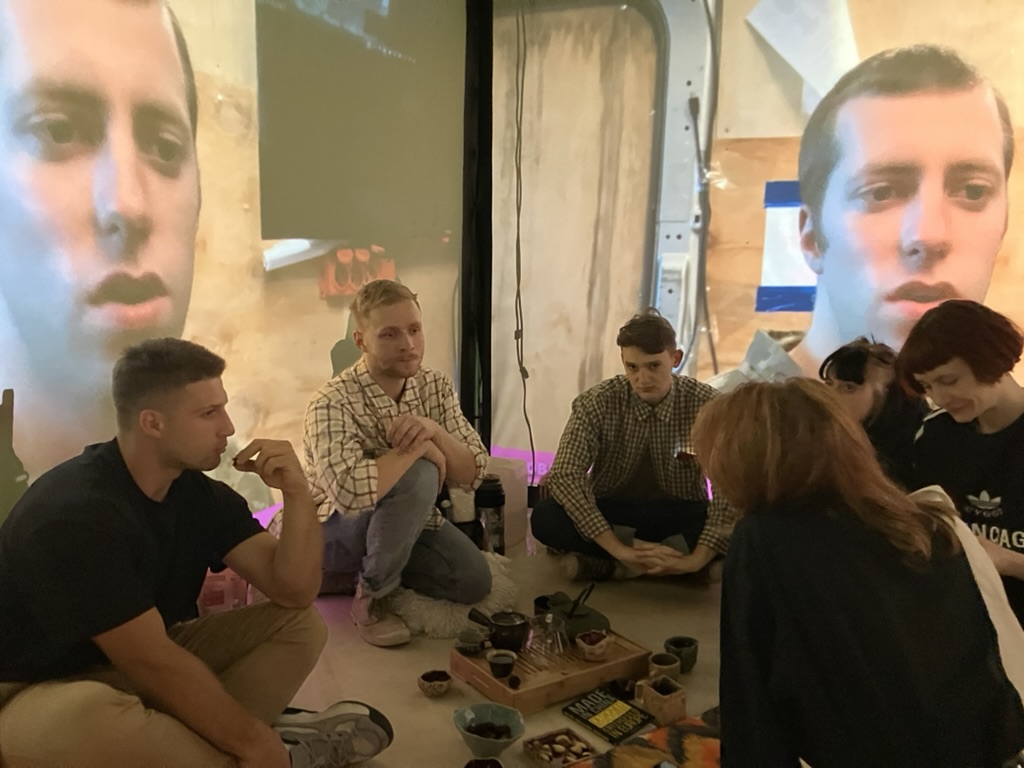
As it turns out, when people are not forced to be interested, they actually become interested. Theory in such an environment turned into something engaging, pertinent, and relatable. And honestly, is there any knowledge more vital at this moment in time than understanding the impact of media and their influence on the direction of societal change? Well, there are also few things more depressing than uncovering the impact of the media on society, but, at least, I put my best effort into conveying these harsh truths in the sexiest way possible. And UKRAiNATV turned out to be the perfect place to realize my intention.
Finally, probably for the first time in my professional career, at UKRAiNATV, my challenging ‘neurological background’ became an asset. Raised less on the introspective medium of books and more on the immediacy of fast-paced FPS games, honed through hours of play preparing for professional tournaments, I always stood apart from my academic peers whose wiring was accustomed to letters firmly remaining in place on the pages they were reading. I, on the other hand, was always subconsciously expecting a rocket coming at my face from the screen. I still hope that they will come but MS Word never fails to bore me. Amid the chaos in the studio, I was able to switch from the literary to the gaming brain.
My heavily electrocuted brain – at least relative to my peers – shaped my perspective on media in a way that diverged from previous generations, largely untouched by the stimulating influence of screens. In this lively milieu of UKRAiNATV, I found my tribe among the GenZers – individuals as electrically charged and perpetually stimulated as myself. Here, my once-perceived dysfunctional, distractible nature transformed into a valuable lens, offering insights into a world increasingly shaped by the rapid pulse of electronic media. This convergence of generational experiences and shared hyper-excitability carved out a niche where my wrecked nervous system could thrive. It was a perfect playground for forever non-serious grown-ups.
Finally, I was where everybody struggled to sit still, I wasn’t alone. Everyone glanced at their phones in response to loud beeps and red dots flashing. Everyone was everywhere all at once. Rom hopped around from one screen to another, somehow managing to operate two cameras, whilst also noticing and resolving all the trash I left behind. Simultaneously, he appeared on the other side of the room to warmly invite guests, introduce some order to the program, come up with some last-moment zany performance, or deliver a sick solo on his electric guitar, improvised rap verses, or punk shouts.
At the same time, Gleb, although always calm on the outside, was setting up hundreds of little things, to make sure that the stream would work, reacted to sudden emergencies, only to then jump behind his hardware and produce sick beats at staggering tempos, and – in probably the most striking plot twists – recite poetry with utter conviction and tears in his eyes.
Then, there was Xenia who tried to somehow make sense of it all, whilst recording this insanity in the form of Instagram reels, taking care of the guests at our studio, conducting one interview after another, and showing off her performance skills. All while taking care of the team’s morale and alleviating conflicts.
Sofiya, the youngest member of our team, was a witch, a singer with a beautiful, powerful voice, a kinky Shibari artist, a twisted fashion designer (think baby hyper-Vivienne Westwood), and a source of endless enthusiasm for the whole team. She could supply energy for an entire city and still have some to spare.
Anna, a performance artist, a photographer, a pole and sash dancer, a camerawoman, and a graphic designer found as often on the stage and behind the consoles. An agent of chaos, always elusive and full of surprises.
Giulia, seemingly the silent one, but don’t let be fooled: her Transylvanian roots pierced through the timid shell. She wrote powerful poetry, created eerie virtual worlds, discussed theory, and did everything necessary so that the show could go on. We needed her calmness and resolve and miss her dearly.
No matter how loud and vigorously I would express myself, I would never match the energies that resided in these people.
In a matter of weeks, this crazy bunch was able to transform me from an avid skeptic and a prophet of techno-alienation through scientific objectivism (your average xenofeminist) into an even more enthusiastic proponent of magic and zodiac signs. I finally grasped what it means that there is little distinction between magic and technology. It takes a merry company and an open studio to completely de-alienate technology and discover its surprisingly connecting aspect. There is another way of doing things with screens and keyboards. We are speaking here of both embodied and spectral connections, converging in a hyper-media environment.
Soon I began to work on combining astrology and media theory, speculating on a future when zodiac sign data would play a key role in our everyday prediction algorithms powered by neural network technology. How could this uproot and transform our civic institutions: from legal to medical? Would it be possible to marry astrology, probability theory, and media theory at an academic conference? Possible but not very probable. Embracing this newfound interest, I enrolled in the convent of cyber-witches. A green box became an ideal haven for exploring digital mysticism. After all, inside a digital studio slightest gesture with the mouse, a wand in this context, brings new worlds to life, duplicates people and makes them float in the air.
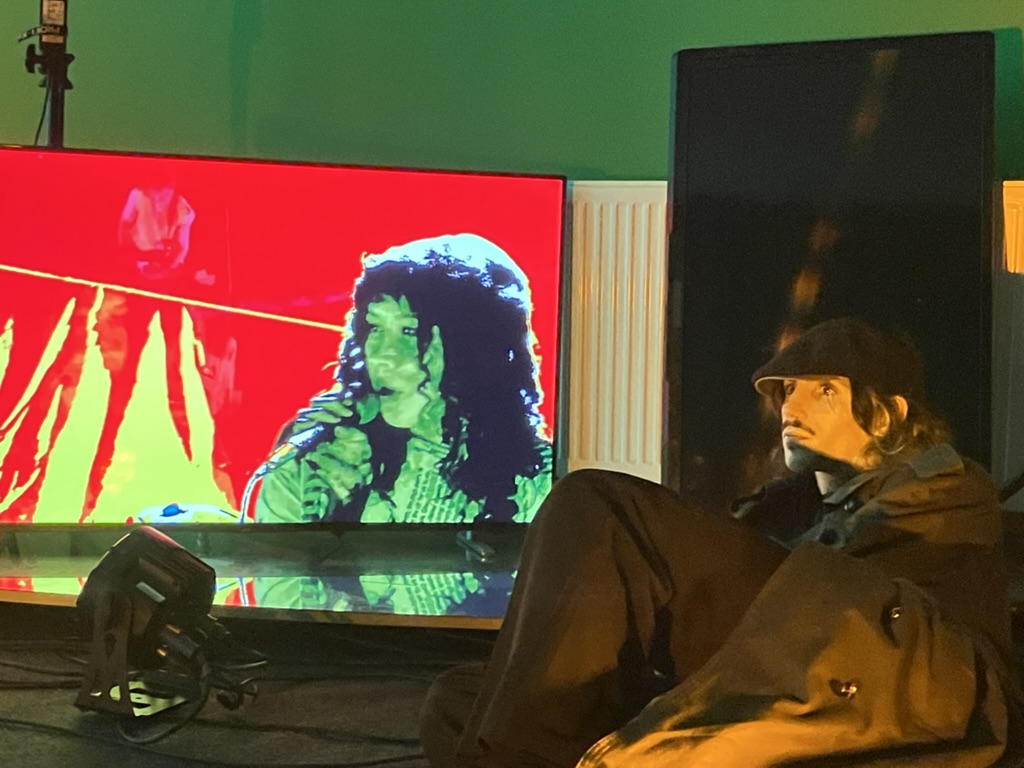
LOOKING FROM AFAR: THEORY
However, UKRAiNATV’s magic is of a modern kind. Digital extensions lead to virtual realms for spells to materialize in, become tangible. Our rituals resemble those of the avant-garde: they are ambiguous, experimental, perplexing, stretched between diverse symbolic registers. Dada was not only an art movement – it was also mysticism of the unsolvable puzzle at the core of reality. No matter how often avant-garde has been declared dead, as it was never only about producing the new. It emerged to challenge the dominant machinic logic prevalent in the industrial era. Dada started by abolishing instrumental reason, asserting that reality can’t be fully grasped. Fluxus took it further embodying the essence of their favourite new medium, the video, that captures the flow of reality itself and not its discrete symbols or icons.
The videotape was analogue, noisy, continuous, and non-binary. The aim back then was to deconstruct and break down the electronic image. Similarly, StreamArt, the aesthetic genre and work method of UKRAiNATV, creates turbulent flows of data, images, sounds, and people. Chaos magic. It presents itself as a cycle: chaos forms order, dissolves back into chaos, and then transforms into another entity. The aesthetics remain noisy and distorted, reflecting a world where objects aren’t fixed but constantly change.
This isn’t just art; it’s a rejection of certainties, a challenge to the either/or 0/1 mindset.
UKRAiNATV’s motto is #HOPECORE. We were critical and what? The Internet became the worst version of itself. Sure, we are finally all connected: crammed in tight interfaces of social media, only to collectively watch ads, cute videos, or gloomy news. The only truth that 99% of the world population would agree on is that the great global system malfunctions. Error after error after error. The Matrix no longer lulls us into pleasant daydreaming. The spectacle is that of horror and fear. Hope fell out of the mainstream and became a defiant feeling. To have hope now is dada.
The roots of our collective are inescapably tied to a traumatic event of war’s escalation. The glitchy, dissociative style (trippy distortions) of Rom and Gleb’s edits resonates and makes this original unrest apparent. Trippiness but not in the style of Merry Pranksters but rather punk and metallic. The global mind is malfunctioning. In line with #HOPECORE ideology, the art of UKRAiNATV never represents, but always projects an image towards the future. The green screen allows us to remove the rug of reality from underneath the people captured on camera.
#HOPECORE also stands for hybrid togetherness.
Some critics may posit that togetherness automatically leads to exclusion. It stinks to them of tribalism which led to no good in modern times. We disagree. The state of togetherness doesn’t need walls that would cut off the chaos of the external world. This is what the populists preach without really offering a solution to contemporary solitude. Rather, it can be a porous entity, a membrane through which uncertainty flows. In this light, being together becomes an act of engagement with the world’s complexities, not a retreat from them. We don’t deny complexity and uncertainty, we play absurd games with them.
For us, togetherness is fundamentally the ‘state of being together.’ It’s not about forming a group with members, but rather an emergent state that arises from the collective being together in hybrid environments. This state doesn’t imply a fixed structure or set properties that identify a group: the goal here is to foster a state of being within an open system. The focus is on creating spatial conditions conducive to interaction and creation, akin to gathering around a bonfire which, ideally, illuminates and warms people sitting hundreds of miles aways. Lastly, this state can operate under loose protocols; the rules for communication and hierarchies are not set in stone but can evolve.
Togetherness distances itself from social enclosures such as ‘community’ with its Catholic origins. Togetherness actively shapes–and defends–diversity, against the lie of unity that needs to be constantly reproduced and policed. Togetherness also takes a clear stand against ‘identity’. Identity is what authorities ask for. Identities are forged for IDs to be handed and to verify accounts in online shops. Today, the awareness of the identity trap is on the rise, especially those that present themselves as ’liberating’, giving fake certainty in uncertain times. All political parties cherish identity in different shapes and forms. We want to submerge and flow with the stream.
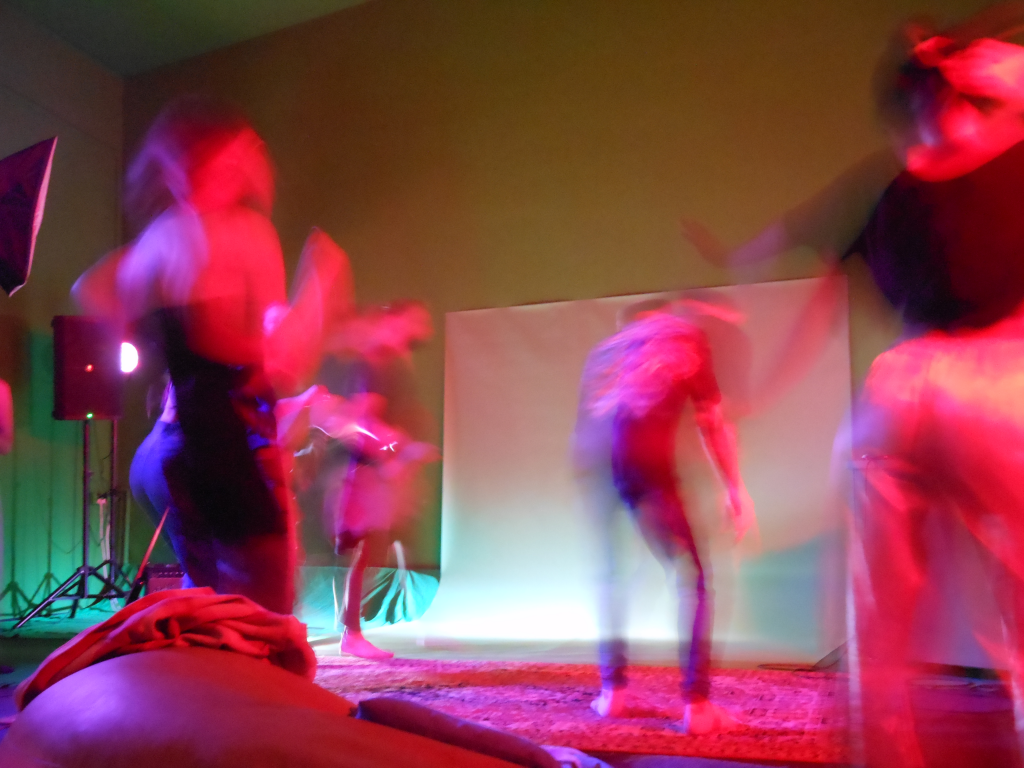
In Polish, togetherness could be translated as wspólnota, meaning a quality of having common traits. This is what connects and bonds, a group formed by its origin, culture, interest, and possessions. All this centres around identity. A better word in Polish would be bliskość, meaning ‘located in close proximity’, ‘to occur in the near future’; ‘recently past; closer, exact, detailed, specified’; ‘related to someone directly; also: expressing such a relationship’; ‘having certain characteristics coinciding with something’; ‘closely united by feelings, views; also: being an expression of such a union.’
The last meaning is closely tied to the English definition of ‘togetherness’ which also points towards the emotional/spiritual effects resulting from close contact between human beings, from emotional bonds or alignment of sensitivities. Building on bliskość, a term that enriches ‘togetherness’ with those emotional and spiritual layers, we arrive at the social vernacular of the ‘vibe.’
Unlike the urban dictionary’s narrow view, the vibe is more than individual emotion or place atmosphere. It’s an emergent now-or-never quality of the open group, not tied to common traits but to tuning into similar frequencies. This isn’t about shared characteristics, it’s about resonances. You either get the vibe—or you don’t (also fine). Each group has its own vibe, linking them to specific localities and shared experiences.
UKRAiNATV’s studio is a dream playground for the neurodivergent multitudes also known as misfits: those who find it hard to remain still and whose passion is deemed excessive by societal norms.
The space thrives on the bursting energy of minds and bodies of those who were irreversibly accelerated by the electronic, over-exciting media. A recluse for those who find ‘work’ – that atrocity created by the agricultural revolution and amplified and further dehumanized by the clockwork rhythms of the industrial world – difficult to accommodate to and can make real things just by playing with others.
The group’s vibe – and its sense of togetherness – is effectively shaped by the hardware that surrounds us. Inside the studio you find a unique mix between the physical and the virtual; it offers and opens a space that allows for simultaneous connection to those physically present and to remote individuals across the globe, alike. It’s akin to stepping inside the medium itself, evoking a Cronenbergian immersion into the hardware of media. You are getting devoured by all those sensors capturing your every move and sound.
Surrounded by cameras in the heart of the studio, you’re not just in front of the media: you’re enveloped by it, you’re a part of its very fabric.
This central position, augmented by multiple computers, offers the freedom to manipulate and reshape your image, liberating you from the identity constraints typically imposed by social media. Being inside the medium, especially with others, transcends the solitary experience of facing it alone, fostering a deeper, more dynamic interaction between the tangible and the digital worlds. The studio allows us to transform, and imagine ourselves differently, and—as we are so stuck in our ways—we should build more spaces like that: portals instead of mirrors.
UKRAiNATV’s frantic and zany vibe fits well with its aesthetics; for and by the electrocuted and displaced. Let’s address the typical UKRAiNATV image, the pink one, the multi-layered one, doubling the characters, casting them from different perspectives, in varied sizes. This is the surreal quest of today, away from the modernist clarity and serenity we put digital baroque as a sign of life, visual multiplicity, ever transforming textures. Are you pink yet?
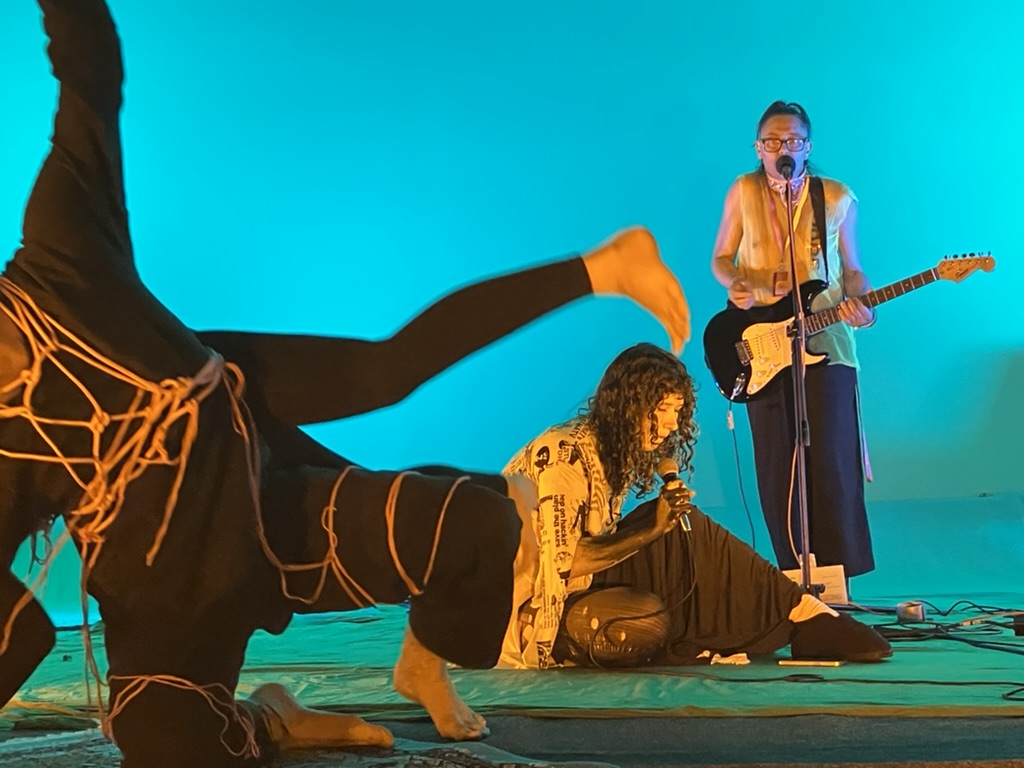
UKRAiNATV’s aesthetics are a carefully orchestrated interplay of digital image layering, Fluidity, Distortion/Noise, and Pink Punk are its three core principles. Each serves as both an artistic technique and a philosophical statement, challenging conventional norms around reality, identity, media standards, and even the aesthetics of resistance.
**Anti-fragility** is the guiding principle behind the events at UKRAiNATV.
While there’s always a plan, the details are intentionally left vague, allowing events to organically emerge from one another. Interruptions, whether they’re human errors like disappearing sounds or mistimed videos, are not only accepted but embraced as part of the creative flow. This approach serves as a critique against the rigidity of professional media standards, which never broadcast the life of the studio. UKRAiNATV, in contrast, showcases the authentic life of a collective, not just individual narcissistic performances for which normal TV stations create perfect, mechanical stages. Everything arrives on time, the illusion is perfect. Here, the bug delivers almost a Brechtian effect. The real of the studio, the real work of the team, becomes visible through the gaps, interruptions, and mix-ups. UKRAiNATV is against Aristotelian principles.
**Layering** in UKRAiNATV serves as a complex mechanism for both the multiplication and dislocation of chosen surfaces. This technique creates an abstract space – a pink and green singularity – that exists in a state of chaotic – yet often quiet and calmly mesmerising – flux, either flattened into a constant stream of pixels or expanded into shifting points of depth. It’s not merely a representational space. It’s an abstraction that challenges the concept of a singular reality with a central point. This layering also allows for the transformation and amalgamation of figures, rendering identity as something that is never fixed but always movable and changeable. While there you’re constantly shifting your attention and jumping from screen to screen to the naked eye vision and back. You experience the vibe of the place and of the people looking at them distorted and displaced in virtual realities.
**Distortion/Noise** is an integral part of UKRAiNATV’s audio-visual strategy.
Far from being imperfections, these elements are a stand against the purity of forms, making the content difficult to digest for the untrained eye. This is not a sign of disinterest in the viewer but a method for securing the freedom that comes with the aestheticization of content.
UKRAiNATV aims to be a hub for associates, not an abstract, disconnected audience. The identity of the platform is further shaped by the experience of war, offering a view of the world through a post-traumatic filter. War turns us Brechtian and dismantles boundaries between spectators, guests, and hosts.
UKRAiNATV makes the ‘seams’ visible by: 1) constantly breaking the fourth wall; 2) making hardware visible; 3) introducing live, random disturbances in the show’s structure; and, 4) treating the image as a work of art.
**Pink Punk** Our colour of choice is pink that combines red for passion and white for purity. Punk adds some impurity.
It’s not just a colour scheme. It’s a political and emotional statement that stands for love, compassion, and hopeful defiance. The term ‘HOPECORE’ encapsulates this ethos, and the use of the pink triangle adds a layer of queer symbolism. This is an act of both resurrecting and queering punk, challenging traditional norms and expectations.
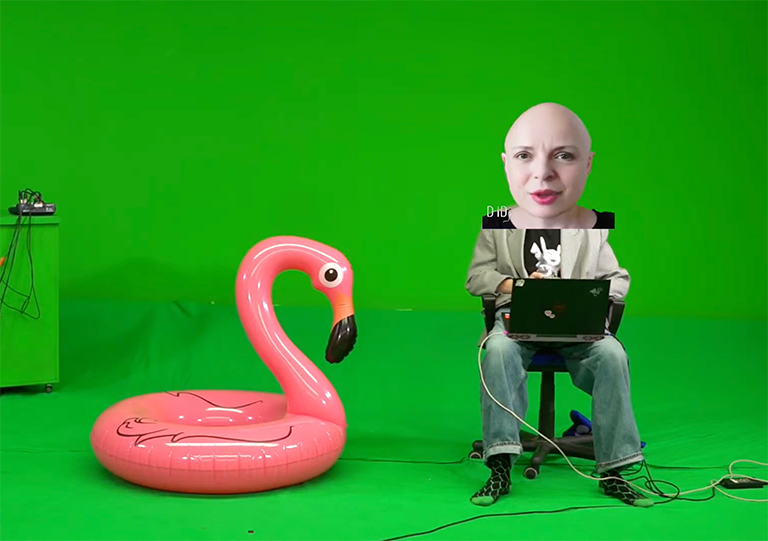
Like many contemporary cultural expressions in Poland, UKRAiNATV was influenced by the savage times of the 1990s with its post-transformation anger, depression and anxiety (which lingered much longer in Ukraine). Counterculture was never that productive in Poland. It always was very much introspective, gazing into itself in a passive-aggressive, destructive manner. Polish punk in the 1990s was absurdly influenced by hippie culture. The squats were often heroin infested because as they existed under constant siege from the joined forces of police and other countercultures. But punk lived on in the arts and blends now in our aesthetics with post-internet exaltations of digital noise.
Like the punks, we create a medium for misfits.
Misfits, nowadays called and medicalized as ‘neurodivergent’ (the first you wear as a badge of honor, the second affords a prescription), have special ways of attaching to media, more intense in the first place, they take it more naively and directly. That’s why experimenting with and creating alternative media environments in these harsh, oversaturated, and boring times is so crucial to them. There is one major problem with this concept because it introduces some sort of us/them divide, but maybe this can be played around smartly?
In the beginning, there was war. The collective was formed days after its outbreak, as a form of direct response to the conflict, and of creating an environment for artists locally, those who came to Cracow shortly after, and eventually those who stayed in Ukraine. War perpetually hovers in the background, yet UKRAiNATV does not allow it to overwhelm the programming. We don’t want to deliver gloomy news from the frontlines or report on opaque diplomatic maneuvers conducted in the world’s oval offices. We want to stay pink! Showcase freak art and music. War might be ever-changing, relentless, but it never takes it easy on those (over)sensitive, the freaks themselves. The noise (distant echoes of artillery fire and drones hovering above the trenches) always creeps in to spoil even the pinkest of broadcasts.
UKRAiNATV is openly anti-Russian – an understandable stance in times of war. The harsh and tragic reality of trench warfare and the constant bombing of the cities tempers its anarchistic idealism. Nation states – especially the big and ambitious ones – are the problem, but as long as Russia occupies and keeps attacking Ukraine one has to conform to, at least in part, a more conservative framework in thinking about politics.
As the project’s poly-lingual foundation and identity are rooted in the full-scale invasion of Ukraine by Russia, it is by nature at the same time anti-imperialist and nationalist. It’s us against them, unfortunately for now. Let’s hope this will change.
How can one combine those stances? Nothing is impossible in hyper-complex and intricately connected reality of the 21st century.
Franco Berardi’s concept of the ‘global psychosphere’ is crucial here for an understanding of today’s conflicts. The conflict in Palestine, viewed from a global lense, seems like it’s an epicentre, and cracks in the nation-state monolith and the Western world order will soon appear. Maybe, paradoxically, it’s a reason for hope, that these cracks will destabilize the post-colonial (post-1945) system of world governance? On the other hand, all this plays so well into the hands of Putin. Ukraine becomes a victim as it evaporates from the news cycles and remains tied to the emerging supervillain, that is, the US. It’s notable that at the beginning of the Gaza conflict in October 2023 Ukraine vloggers who were reporting from the frontlines attached military information about the situation in Gaza but then quickly dropped the topic.
I get worried because the global psychosphere is not a unity. It is fractured, traumatized, dissociated, a divided brain where some regions have lost connections with others. It’s not only about the South vs North, the colonizing and the colonized, the imperialists and the pacifists. There are more forces and many perspectives at work. The only certain thing is that the West is failing at its tasks, both in Palestine and Ukraine, and playing to the hands of all its potential enemies. And there a multiple reasons for that happening. We are indeed living in interesting times, the ground is trembling. We even would take postmodern groundlessness over these trembling grounds now, right?
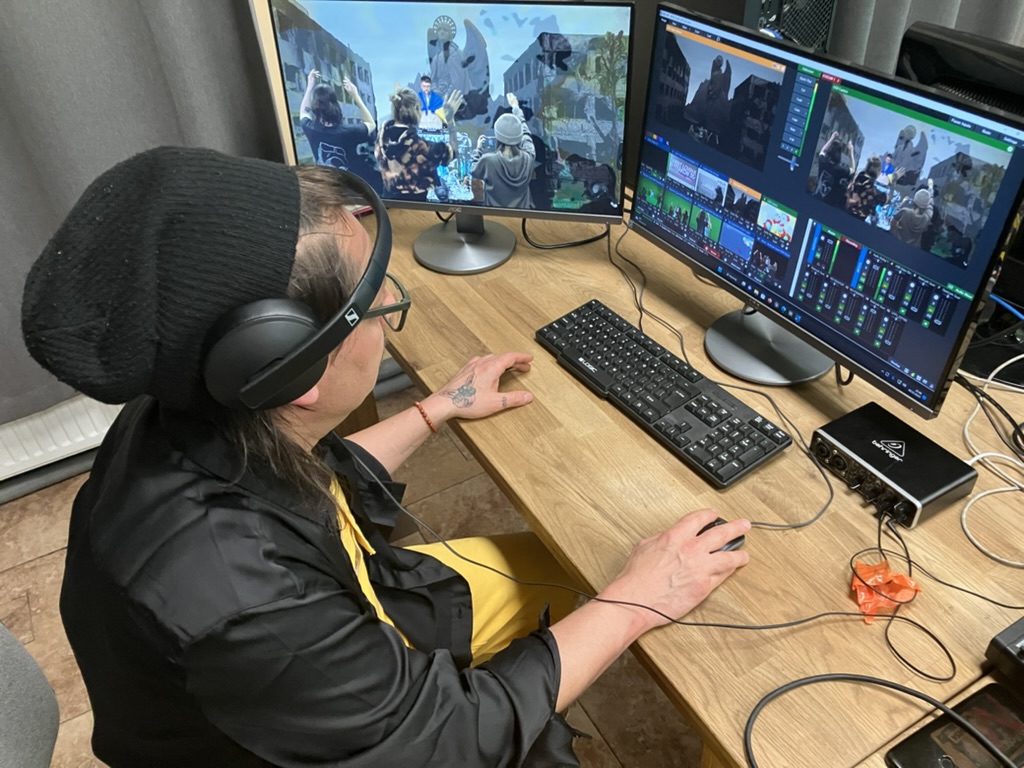
The mainstream media represent an important piece of this puzzle. Even the general public is growing increasingly sceptical of the mainstream media, perceiving them as less trustworthy. But are we left with a choice between depressed and depressing TV coverage of global events and paranoiac alt-media? [1] The first wave of media collectives’ initiatives in the 90s succumbed to the dehumanizing forces of capital and the centralizing pressures of companies like Google, Facebook, etc. When we were given a choice, we chose poorly. Maybe now, when pressured and stripped of illusions, we will kickstart something truly different? A third way that is neither depressing nor paranoiac; not fuelled by anxieties, but by a need to connect and support each other. ‘The medium is the message’: no content will comfort us, only true proximity and connection. #HOPECORE. UKRAiNATV emerged in times of deep crisis, out of a deep need to act and create something of real, tangible substance. Perhaps we will be able to capitalize on the dire situation we found ourselves in. What’s different in our approach is that we don’t turn away from the mainstream media but use them to our advantage. We have no choice but to pick up the scraps left by them.
UKRAiNATV wants to be parasitic. It operates as and uses tactics of a small-medium that feeds on bigger unspecified internet and art infrastructures. However, it is not against those infrastructures. It acknowledges that it is necessary to find a place within larger structures, both institutions and platforms. UKRAiNATV criticizes and opposes platformization of the Internet as it standardizes the experience of ‘users’ who cannot ever transcend the limits of social media interfaces such as Meta/Facebook/Instagram, Google/YouTube but also Twitch. However, it also recognizes the need to remain present on those platforms to broadcast its signal beyond the very narrow range afforded by alternative channels.
Some visibility is necessary, especially if you want to reach beyond the local context. Without connecting through technologies of global broadcast, tribes cannot reach other tribes and risk becoming alienated. When these resources, akin to abandoned and unprotected houses available for squatters, are not freely accessible, one must depend on some institution to achieve independence. This is a paradox, but it remains the only option. Only then tending to one’s garden is truly feasible.
UKRAiNATV needs to feed on something bigger to survive. Capitalism compels artists into a parasitic existence. This can work until there is an overabundance of resources produced by large players.
Nonetheless, small media like UKRAiNATV find themselves stifled by dominant players imposing standards on content formats (UI) and aesthetics (mainstream). Smaller platforms that emerge outside the potential – and severely limiting – space of social media cannot compete with such architectures in terms of range and content ‘quality’ which is nothing else than the professional standard of formatting messages, supported by popular vote and algorithms. For that reason, streaming on such platforms – multiple at the same time – occurs in disadvantageous conditions.
UKRAiNATV produces its own unique image flow which is formatted to fit the screen and not any specific platform’s interface or its preferred formats. Freedom and openness of such enterprises hardly translate to popularity of these platforms. For too long now, the crowds have been desensitized to appreciate those values and with algorithms lurking and hunting for any deviations from arbitrarily constructed visibility norms, the transgressions are even rarer.
It is hard to predict how the digital landscape will evolve in the future, but the cycle of migrating from one platform to another is destined to end, eventually, as all platforms try to mimic others’ success which results in all becoming the same tool with a slightly different user base. Change nowadays leads to uniformity. The adaptability of AI tools may lead to a complete restructuring of the internet as its users might be able to find ways of navigating through vast databases without resorting to major media platforms that organize these databases for them. Against such a technological backdrop, smaller media platforms, like UKRAiNATV, could provide a viable alternative to big conglomerates, especially given that in the age of automatization of content production, the value of well-produced, normative content should plummet.
UKRAiNATV is post-internet to the core, because of its seemingly dated attachment to a physical space. To fully appreciate the collective’s activities, experiencing the weekly live events every Thursday evening, which unpredictably unfolds in the backyard of Berka-Joselewicza Street, is recommended.
The large green screen wall, surrounded by cameras, connected to live-mixing equipment, and screens that immediately project the mixed-reality image, is a quasi-virtual space in itself. It exists about and around these cameras, computers, and screens. Here, the standard boundary between virtual and analogue – usually dividing the user’s physical space and the virtuality of the screen – runs straight through the studio. The human/technology divide is thus breached.
Despite its tentacular structure that spans from Kyiv to distant Trondheim, and other cities across the world, there is a vibe of homeliness in all of UKRAiNATV’s webcasts. Its green-screen box is like a world in itself: happily detached from global communication systems, their repetitive visual styles, interfaces, norms of conduct and forged openness.
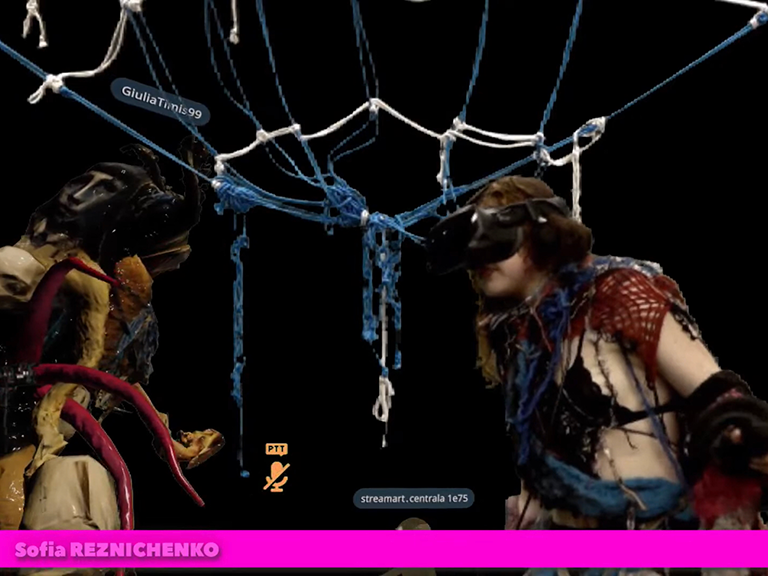
UKRAiNATV: by and for homiest audiences.
It has aims and values, but human connection in art and play matters more than serious programming. Medium (energy and information) rules over content (form and meaning). Rules and norms for producing programs do, of course, exist, though, they can be challenged. When something misfires, the team is ready to change its ways and adapt. For free-will-sceptics, this is of the greatest importance, as it introduces a degree of freedom into the team’s operations in the resulting image-as-a-work of art.
UKRAiNATV improvises, creates sparks, and starts fires. Emotions and risks are included.
Let’s compare two visual paradigms of TV programming: centre-oriented in regular TV (news, talk shows) and the distorted, off-centre visual style of UKRAiNATV.
The orientation on the central figure in news programs facilitates rapid transitions between diverse footage from across the globe. Without a centrally positioned presenter, the barrage of scenes captured worldwide and rarely sorted chronologically – as the common practice is to order them arbitrarily according to presumed importance for the viewers – would probably result in a confounding and dizzying viewing experience. After every trip to a different space, we return to the safe harbour of the studio where we can see the same person announcing the next space-time jump. Thus, the producers of the news establish a linear time that safely and securely binds together disjointed fragments of the program.
UKRAiNATV explicitly abandons this centralist paradigm and consistently employs tilted or distorted views of characters on screen. The figures eerily float in the air or are eerily doubled or split in the middle. Sceneries shift dynamically and visual effects are creatively added. Time also unfolds linearly, as every ‘EFIR’ (meaning эфир, ether or aether) session is live recorded, but this is not the same kind of sewn-together linearity of standard TV experience. Rather, we experience the flow of the images continuously. This effect is even strengthened by the visibility of technical seams—the camera crew gets in the picture, transitions from one material to another are delayed, etc. There exists a real, unpredictable life off-screen, adding a layer of authenticity. It might be irritating for the eye accustomed to the conventions of regular TV, but even despite intense live-mixing of the image flow, it remains more honest. TV sur-verité.
If standard TV is Vitruvian with its attachment to central perspective, the space of social media lacks a horizon. The practical infinity of feed is ever-expanding. Thus, it also lacks a natural point of focus and fucks up our attention. The slow and steady flow of UKRAiNATV’s streaming files and the discernible teleology of the image pose a challenge to the infinity-hooked cognitive apparatus of those accustomed to The Feed.
Regarding the interface’s visibility: media fundamentally rewires us. In the user-friendly interfaces and smooth image aesthetics this dynamic is hidden.
If the central perspective is associated with vertical power structures like monarchy, and the absence of a horizon in social media reflects the postmodern disappearance of power, then the multitude of focal points and distorted figures may represent more horizontal, collective forms of societal organization. The collective is a useful intermediary form between the individual and the society. In the state/corporate model of governance, big social and hierarchical structures always dominate over small groups that operate differently (emotional bonds between members are key, empathy is necessary). The freelance model seemingly offers freedom to the individual but at a price of isolation. The freedom in the collective is intersubjective. It is not the individual choice that matters but the creative spark in communication between members which leads to the creation of new ideas.
Three theses on media collectives:
1) We are accustomed to the fact that media belong to the order of the state (either directly subsumed or modeled after, see Citizen Kane). They are the most efficient way to distribute important information. Their role in bringing them shapes the expectations of the audience (people get hooked on news). The individual and the familiar can only appear as a dramatized and standardized show. Media collectives produce and distribute minor news that concerns mostly their global environments.
Less dopamine, but also less alienation. It’s a fair deal.
2) Media collectives should exist within a network of other collectives and also bigger networks that can connect them. Presence within such a larger network endangers their autonomy, but at the same time allows them to remain open to new encounters.
Full autonomy is isolation. The minor network collapses onto itself.
3) Media collectives play the role of hubs for local communities and link other collectives together. Hence, their role is not only to produce and transmit new information but also to connect people.
There is an ethical dimension to media collectives’ activity. As banal as it sounds, the architecture of social media reminds one of the infamous Panopticon. Here, everyone gazes at everyone else through small windows (profiles) with an invisible disciplining force at the centre that sees it all and affects who sees what.
—

Konrad Wojnowski works as an assistant at the Jagiellonian University (Performativity Studies Department) in Krakow, Poland. He is the author of Aesthetics of Disturbance (Estetyka zakłócenia) on strategies of disturbance in the cinema of Michael Haneke, Productive Catastrophes (Pożyteczne katastrofy) on the concept of catastrophe in the context of contemporary techno-culture. Early 2024 Edinburgh University Press published Probabilistic Aesthetics of the Avant-Gardes on the probabilistic revolution in the arts in the first half of 20th century. His research interests span theories of performativity, philosophy of communication, and various intersections between culture, science, and technology.
Notes:
[1] There are three directions of mental disturbances related to different sides of the political spectrum:
- The Left and Anxiety Disorders:
A constant struggle for inclusivity and equality can be seen as a form of social anxiety, focusing on the precariousness of life, always waiting for the next shoe to drop. (anxiety as excessive worry and apprehensive expectations – DSM-5).
SLOGANS: Healthcare is a political right (do you ever worry if you get sick? You should!).
Climate justice now (we’re all going to burn soon, CAN YOU FEEL IT?).
Defund the police! (medium is the message, no one holding a gun can be trusted!). Introduce UBI (maybe if we had guaranteed money, we would worry less?).
Theories: especially Butler, Crenshaw and Zizek (the poor guy is shaking).
- The Right and Psychosis:
Conspiracy theories and strongman politics as a form of collective paranoia and the creation of alternate realities (post-truth). In DSM-5 psychosis is defined broadly as “gross impairment in reality testing” or “loss of ego boundaries”.
SLOGANS: Take back control (we’re out of control!). Make smth great again (delusions of grandeur). Build the wall (otherwise I won’t be able to separate inside from outside)
Theories: Hofstadter, Baudrillard, Agamben, Neo-Darwinism, Deleuze & Guattari, Land.
- The Centre as Depression:
Liberal democracy as the end point of human governance must lead to depression (at least on the level of political activity), and never fully committing to anything (being unable to commit?). Depression is a mood disorder that causes a “persistent feeling of sadness and loss of interest” (DSM-5).
SLOGANS: Finding a middle ground (where no one wants to live). Responsibility, fiscal or other (you shall not have fun!). Unity over division (a blob). Stability above all (even in the terminal phase). Pragmatism (to what ends?). Individualism above all (even if that means 40 days in the desert). Work hard! (and eventually work yourself to death).
Theories: Fisher, Fukuyama, Giddens.


